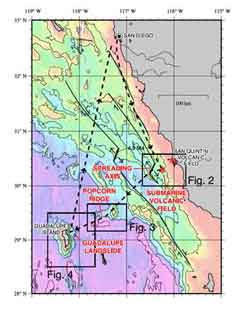Scripps Researchers Rediscover Elusive Site of Exploding Volcanic Rocks

’Popping rocks’ found in deep sea give researchers clues about rare gases from ’young’ seafloor volcano
Scientists aboard the Scripps research vessel Roger Revelle this week solved a 45-year-old geological mystery.
In 1960, Scripps oceanographer Dale Krause reported the discovery of extraordinary deep-sea volcanic rocks in waters off Mexico, near Guadalupe Island, approximately 200 miles south of San Diego. When brought to the surface, the rocks spontaneously exploded “with a sharp snapping sound,” according to Krause.
Since then, only a few other sites, mostly along the Mid-Atlantic Ridge, have been reported with similar “popping rocks.” An attempt by the late Scripps Professor Harmon Craig to locate the site in 1984 proved unsuccessful, largely because the location of the original discovery lacked the precision of today’s navigational technologies.
A team of U.S. and Mexican geologists and student researchers aboard the Oct. 5th to 10th Revelle expedition explored the region, including the area now known as Popcorn Ridge, in an attempt to precisely locate the source of Krause’s popping rocks and the unique information these rocks could provide about important Earth processes.
Three dredge hauls of Popcorn Ridge on Oct. 7 recovered some volcanic rocks, though none “popped” on deck. A sonar survey of the seafloor revealed a small mound, which was later identified as a volcano, at the base of Popcorn Ridge, 3,200 meters (10,500 feet) below sea level. On Sunday, Oct. 9, the researchers hit the jackpot with ’D-11,’ or the 11th area dredged during the expedition. D-11 is located along the flank of what the scientists are now calling “Krause Volcano.”
“As soon as we took the rocks out of the water we could hear them popping, much like a firecracker,” said Barry Eakins, a post-doctoral researcher at Scripps and one of the chief scientists on the cruise. “We were very excited because we knew this was a big find.”
Eakins and co-chief scientist Dana Vukajlovich, a Scripps graduate student, say the loud popping sounds are due to high concentrations of volcanic gases trapped in bubbles within the lava rocks that explode when they escape the confining water pressure of the deep ocean floor. The scientists consider the rediscovery an important achievement because it will give them the opportunity to study these rare rocks in their Scripps laboratories and to compare them with the popping rocks from the Mid-Atlantic Ridge. It also allows other scientists to return to the site, since the precise, GPS-marked location is now known.
Vukajlovich says that the rocks are important because the volcanic gases (such as carbon dioxide, water vapor, helium and argon) that are trapped in the bubbles did not escape during eruption and therefore should represent the concentrations of these gases in Earth’s mantle. Eakins believes the rocks will not only give researchers more information about the inventory of these gases within Earth, but also help them better understand the origin and history of Earth’s atmosphere. “We expect that these rocks will be the source of research for decades,” Eakins said.
The rediscovery also will provide new information about seafloor volcanoes. The researchers characterized Krause Volcano that provided the popping rocks as very young—from decades to a few centuries old—which is a rare find.
“There are lots of volcanoes on the seafloor but most are quite old,” said Vukajlovich. “It’s exciting to find one that may be very, very young and possibly still active.”
According to Scripps Professor Peter Lonsdale, detailed analyses of the gas chemistry and isotopic composition by Vukajlovich and others in Scripps labs will provide important information about the composition and origin of the mantle beneath oceanic crust.
The Revelle cruise was funded by the University of California Ship Funds Panel of the Marine Operations Committee.
Media Contact
More Information:
http://www.ucsd.eduAll latest news from the category: Earth Sciences
Earth Sciences (also referred to as Geosciences), which deals with basic issues surrounding our planet, plays a vital role in the area of energy and raw materials supply.
Earth Sciences comprises subjects such as geology, geography, geological informatics, paleontology, mineralogy, petrography, crystallography, geophysics, geodesy, glaciology, cartography, photogrammetry, meteorology and seismology, early-warning systems, earthquake research and polar research.
Newest articles

Durable, Efficient, Sustainable: The Rise of Cerium Oxide Thermal Switches
Groundbreaking cerium oxide-based thermal switches achieve remarkable performance, transforming heat flow control with sustainable and efficient technology. Cerium Oxide-Based Thermal Switches Revolutionize Heat Flow Control Thermal switches, which electrically control…

How Industrial Robots are Reducing Emissions in Global Manufacturing
A new study explores the intersection of industrial automation and environmental sustainability, focusing on the role of industrial robots in reducing the carbon intensity of manufacturing exports. The research demonstrates…

Patients Can Heal Through Precise, Personalized Bioceramic Grafts
A recent review is transforming the landscape of craniomaxillofacial bone regeneration with the introduction of personalized bioceramic grafts. This pioneering research explores the fabrication and clinical potential of synthetic grafts…



